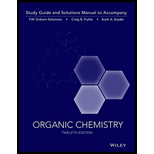
Concept explainers
Interpretation:
The structures of the compounds A, B, C, and D are to be proposed with proper stereochemistry.
Concept introduction:
舧 Electrophiles are electron-deficient species, which has positive or partially positive charge. Lewis acids are electrophiles, which accept electron pair.
舧 Nucleophiles are electron-rich species, which has negative or partially negative charge. Lewis bases are nucleophiles, which donate electron pair.
舧 Substitution reaction: A reaction in which one of the hydrogen atoms of a hydrocarbon or a functional group is substituted by any other functional group is called substitution reaction.
舧 Elimination reaction: A reaction in which two substituent groups are detached and a double bond is formed is called elimination reaction.
舧 Addition reaction: It is the reaction in which unsaturated bonds are converted to saturated molecules by the addition of molecules.
舧 The reaction in which there is addition of hydrogen molecule is called hydrogenation reaction.
舧
舧 The formula of degree of unsaturation (U) can be represented as
Here,
舧 Alkyl halides react with magnesium in ethers to give the Grignard reagents, which react with aqueous acid to give alkanes.
舧 Alkyl halides with a β�-hydrogen in anti-periplanar arrangement can react with strong base like sodium ethoxide in ethanol to yield alkenes.
舧 Alkenes react with ozone and subsequently work up with dimethyl sulfide (DMS) to yield aldehydes or ketones.
Want to see the full answer?
Check out a sample textbook solution
Chapter FRP Solutions
Organic Chemistry, 12e Study Guide/Student Solutions Manual
- 5barrow_forwardCompound A (C5H8) readily reacts with bromine (Br2) at room temperature to discharge the purple colour of bromine and form Compound B (C5H8Br2). When Compound A is treated with H2 in the presence of a transition metal catalyst, it is converted to compound C (C5H10). When treated with HCl, compound A is converted to compound D (C5H9Cl). B, Cand D are saturated compounds. Given this information, propose structural formulas for compounds A, B, C, and D.arrow_forwardCompound X, C7H14 undergo hydration to form Y which is optically active. X reacts with cold alkane potassium permanganate (VII) solution to form Z. Ozonolysis of X forms methanal and 3,3-dimethylbutanal. Deduce the structure of X,Y and Zarrow_forward
- Draw the structure of the predominant form of CF3CH2OH (pK a = 12.4) at pH = 6.arrow_forwardNn.42.arrow_forwardA chiral amine A having the R configuration undergoes Hofmann elimination to form an alkene B as the major product. B is oxidatively cleaved with ozone, followed by CH3SCH3, to form CH2 = O and CH3CH2CH2CHO. What are the structures of A and B?arrow_forward
- (b) Reactivity with the S1 by the treatment with NaOH Br Br I t 2 (c) Solubility in hexane: Br H3C-Brarrow_forwardKk.296.arrow_forward3. An optically active compound A has the molecular formula C6H140. This compound reacts with Na2Cr207 in sulfuric acid to form a new optically active compound B, with the molecular formula C,H12O. Suggest structures for A and B.arrow_forward
- The reaction of N−bromosuccinimide with 4−methyl−3−nitroanisole has been reported in the chemical literature. This reaction yields a single product in 95% yield. Identify the product formed from this starting material.arrow_forwardA chiral amine A having the R conguration undergoes Hofmann elimination to form an alkene B as the major product. B is oxidatively cleaved with ozone, followed by CH3SCH3, to form CH2 = O and CH3CH2CH2CHO. What are the structures of A and B?arrow_forwardHydrocarbon A has the molecular formula C14H10C12. It absorbs eight molar equivalents of any hydrogen isotope using a Nickel catalyst. When subjected to ozonolysis, Compound A yields oxalic acid and the chiral chloropentane dioic acid. Write the reactions and propose a structure for A.arrow_forward
 ChemistryChemistryISBN:9781305957404Author:Steven S. Zumdahl, Susan A. Zumdahl, Donald J. DeCostePublisher:Cengage Learning
ChemistryChemistryISBN:9781305957404Author:Steven S. Zumdahl, Susan A. Zumdahl, Donald J. DeCostePublisher:Cengage Learning ChemistryChemistryISBN:9781259911156Author:Raymond Chang Dr., Jason Overby ProfessorPublisher:McGraw-Hill Education
ChemistryChemistryISBN:9781259911156Author:Raymond Chang Dr., Jason Overby ProfessorPublisher:McGraw-Hill Education Principles of Instrumental AnalysisChemistryISBN:9781305577213Author:Douglas A. Skoog, F. James Holler, Stanley R. CrouchPublisher:Cengage Learning
Principles of Instrumental AnalysisChemistryISBN:9781305577213Author:Douglas A. Skoog, F. James Holler, Stanley R. CrouchPublisher:Cengage Learning Organic ChemistryChemistryISBN:9780078021558Author:Janice Gorzynski Smith Dr.Publisher:McGraw-Hill Education
Organic ChemistryChemistryISBN:9780078021558Author:Janice Gorzynski Smith Dr.Publisher:McGraw-Hill Education Chemistry: Principles and ReactionsChemistryISBN:9781305079373Author:William L. Masterton, Cecile N. HurleyPublisher:Cengage Learning
Chemistry: Principles and ReactionsChemistryISBN:9781305079373Author:William L. Masterton, Cecile N. HurleyPublisher:Cengage Learning Elementary Principles of Chemical Processes, Bind...ChemistryISBN:9781118431221Author:Richard M. Felder, Ronald W. Rousseau, Lisa G. BullardPublisher:WILEY
Elementary Principles of Chemical Processes, Bind...ChemistryISBN:9781118431221Author:Richard M. Felder, Ronald W. Rousseau, Lisa G. BullardPublisher:WILEY





